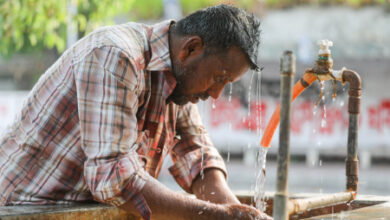India must play a proactive role in climate and health diplomacy at COP
The COP 28 declaration will call for the need for the health care sector to walk the talk on climate action by reducing its own emission footprint.

By Soma Das
It has been a strain to establish that farmer suicides in India are linked with the climate crisis, mediated by rise in temperatures, rainfall deficit, dropping crop yield, rising debts and mental health. This level of complexity is what has kept the climate-scientists and public health specialists away from what should have emerged as a discipline by now—climate and health. That seems set to change in the COP28 at Dubai which has for the first time promised to bring the yet to be articulated climate and health to the centre of global climate negotiations, and even dedicate a day to it.
Drawing from the hints thrown by host country leaders, three themes are likely to dominate COP28 in the climate health space—the need for health systems to go green; to increase climate finance pie overall and mobilise allocation to health within the climate finance; and design cross-sectoral collaborations between climate and health, mainstreaming health in climate policies.
India has both the stake and clout to take a central position in climate and heath diplomacy. India’s stakes are clear from this—the country lost about 190 billion workhours to heat in 2022, accounting for a staggering 38.9% of the total global loss, reckons an estimate of Lancet Climate and Health Countdown released in November.
It’s clout in the space, as a leading voice for Global South, started building up during the recent G-20 presidency. The health track of G-20 under its presidency for the first time explicitly mentioned the need to address the nexus of the climate crisis and health, which Brazil has promised to carry forward under its G-20 presidency and Asia Development Bank is setting up its climate and health hub in New Delhi. This groundwork must be consolidated and carried forward during the COP28 negotiations.
While India’s position on increasing resource allocation for health in climate finance, and mainstreaming health in climate policies should be non-contentious, its position to globally commit to low-carbon health systems by 2050 needs to be more nuanced and informed by evidence from country’s own realities and contexts of Global South.
The COP 28 declaration will call for the need for the health care sector to walk the talk on climate action by reducing its own emission footprint. Health care sector accounts for about 4.4% of global emissions, and had it been a country, it would have been the fifth largest emitter globally. Hence when it comes to global health-systems’ commitment towards becoming climate-resilient, low-carbon sustainable and equitable, India’s position should be clearly and unequivocally in favour of that path but not without espousing the common but differentiated responsibilities (CBDR) principle. A central principle of global environmental policymaking, the CBDR underpins that while attaining net-zero health systems by 2050 is the shared goal of all countries, the action to be taken for different countries will be varied based on their historical contribution, their ability to respond and other significant variables determining equity in this context.
That’s because to forge a feasible and equitable trajectory towards net-zero health systems, it is important to factor in that the journey to low-emission health systems doesn’t adversely affect access to health care, particularly for the most vulnerable population.
And thus, while designing the global scale of responsibilities on which countries need to shoulder how much share of responsibilities and how soon, the international governance framework must go beyond just country-wise emission figure, which remains an important but not the sole determinant for scripting the journey to emission free health systems.
The framework and path for fixing responsibilities and convincing countries to shoulder such responsibilities should include indicators like country’s per capita emission in health care, the single most potent indicator to capture equity in this situation; health care expenditure as a share of Gross Domestic Product (GDP), found to be strongly correlated with country’s per capita health emission; health care’s emission contribution to country’s overall emission; how strongly are the emission rates from healthcare sector correlated with increase in healthcare expenditure in the past few decades, and most importantly where does the country figure in ensuring access of health care to all its citizens.
Assessing India’s position in health care emissions from existing evidence base shows a curious case. While the headline grabbing finding has been that India is one of the top ten largest emitters globally, this masks many other realities which may show that not only India’s healthcare sector (particularly hospitals) doesn’t stand out as a major offender in emissions—but also addressing the existing red flags in emissions by nudging the right actors, and pressing the right levers may not be as onerous a task as it may seem on the surface.
For one, despite having the seventh largest health sector emission footprint in absolute terms globally, India has the lowest health-related emissions per capita of all countries assessed, according to Healthcare Without Harm (HWH), a global NGO which has attempted the most detailed study on the subject.
Accounting for only 1.5%, the share of India’s health sector in country’s total emission is the lowest globally of the 43 countries studied by HWH. This when the global average for the same stands at 4.4%, and 39 countries had health care making up over 3% of their total emission, at-least double of India’s figure. This is partly because investment in India’s health care sector as share of its GDP is also among the lowest at 3.8%. This could mean that as India’s health care infrastructure particularly on the delivery side expands with a fast-growing economy, its emission footprint could balloon as well. However, credible time-series global studies observe an interesting trend—India’s health care emission rates are growing albeit at a slower rate than its growth of health care expenditure. Also, digging deeper into the break-up of India’s health emissions, one finds the core health care delivery system—hospitals and health care facilities account for only 8% of emissions—while over 80% of current health emission is from manufacturing, transport, and logistics of pharmaceuticals, chemicals, medical devices, hospital equipment among others.
This is revealing mainly because of two reasons—first, being a source of cheap medicines, and vaccines for the world means that a sizeable share of India’s health emissions might be ensuring access to health care outside the country. So, while planning the transitions towards low-emission health systems, India should estimate using evidence how much of the emission pie generated in the country is going towards ensuring access to health care globally, particularly low-income countries of the Global South, for which the country has emerged as a strong representative voice in the climate diplomacy space.
Second, the country’s overall net-zero transition roadmap at a national economy level with a strong push for renewable energy in sustainable transport and green logistics space will likely have a strong impact on healthcare, if planned in an integrated manner.
It is encouraging to see that India has already begun an audit exercise to see how its hospitals are using up energy. However, it is only when the country negotiates in global platforms like COP28 for an equitable staggered timeline for implementation of low-emission health systems, and makes a case for using that time window for tech-transfer of cost-effective solutions that can be adapted into Global South contexts, can the miles to green health systems be covered without hurting the last man standing in the queue in need of a basic health care service.
This article is authored by Soma Das, former journalist specialising in health sector and senior advisor to Chase India in development space and Manash Kalita Neog, MD and co-founder, Chase India.




